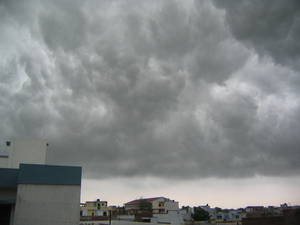A paper published in the journal science shows that pollution in Asia gets pushed up into the stratosphere by hitching a ride on the monsoon.
William Randal at the National Center for Atmospheric Research, Boulder, Colorado, and an international team including researchers at York and Edinburgh Universities, used satellite imaging to keep track of hydrogen cyanide, a pollutant associated with burning that usually stays mainly in the troposphere - the lowest portion of Earth's atmosphere.
 Hydrogen cyanide is a particularly apt choice as most of it is lost to the ocean - there's relatively little high up in the troposphere, so with normal circulation there will be little to move into the stratosphere.
Hydrogen cyanide is a particularly apt choice as most of it is lost to the ocean - there's relatively little high up in the troposphere, so with normal circulation there will be little to move into the stratosphere.
In general, air is circulated from the troposphere to the stratosphere (the next layer of the atmosphere - starting somewhere between 10 and 50 kilometers altitude) at the tropics, as part of something called the Brewer-Dobson circulation. But this paper shows that the Asian summer monsoon acts as an effective pathway for rapid transport of air upward from the Earth's surface, which in turn provides a route for pollutants like black carbon, sulfur dioxide, and nitrogen oxides to gain access to the stratosphere. This route is there because the monsoon itself contains a strong anticyclonic votex - a circulation of winds around a high pressure region that pushes air up from the ground.
Once pollutants get into the stratosphere, they're likely to be moved around the world, and impact on atmospheric chemistry, such as reacting with ozone - it also creates a barrier between some pollutants, such as HCN, and the ocean, which acts as a sink. In the atmosphere, HCN has a lifetime of around 4 years.
This gives us cause for concern, for not only is the industrial pollution of Asia increasing at an unprecedented rate, but it seems to have a pipeline direct to the stratosphere. So pollution from Asia could have a greater effect on atmospheric chemistry than we've thought possible.
- Previous Toads tuned to earthquakes
- Next Snail inspired coatings










Comments
Add a comment